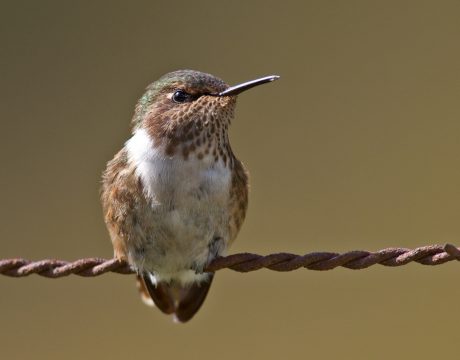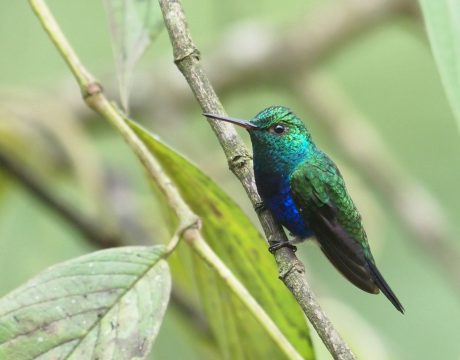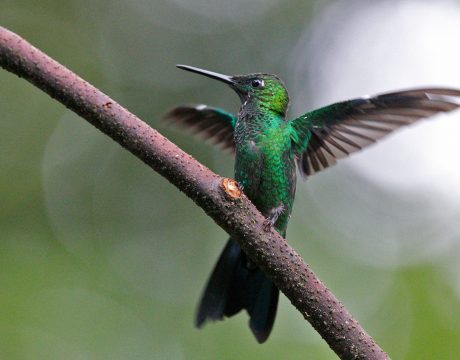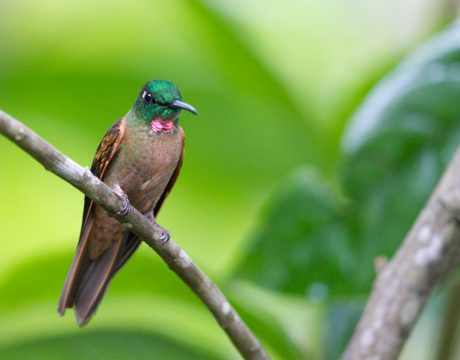Return of Bird of the Week: Volcano Hummingbird
The Volcano Hummingbird is tiny, even for a hummingbird, just 7.5 centimeters (a little less than 3 inches) long. It also has a tiny habitat, ranging in the higher mountains of Costa Rica to western Panama. And within that habitat it prefers to scrubby vegetated areas. In that part of Central America, taller mountains tend to be volcanoes; hence, the species’ common name. The background in this first photo is in fact a volcanic cinder field. The species also has tiny territories, in some cases just 15 square meters, which the males defend aggressively. Unlike a lot of hummingbirds, the…
Return of Bird of the Week: Violet-bellied Hummingbird
Among birders’ favorite hummingbirds has to be the Violet-bellied. Not only is the male’s coloration spectacular; this species favors the flowers of the understory, making it more accessible than most hummingbirds. And it is sometimes attracted to feeders. It’s a handsome bird from this angle, but when it catches the light right, well. It can make your eyes water when you see it through your binoculars. This is a small hummingbird, about 7.5 cm – just under three inches – long, weighing just 3.4 grams. But it certainly has the most flash per gram of any bird in the Western…
Return of Bird of the Week: Green-crowned Brilliant
There are eight species of Brilliants; WC has photos of four of them. If anything, this species iseven more territorial and belligerent than its Fawn-breasted cousin. This male is making a threat display against a rival or another hummingbird. WC has more than two dozen photos of this hummingbird reacting in this way. So, yeah, territorial. This is a largish hummingbird with a comparatively short, stout bill. The male is metallic green over all with an iridescent green head and a bluish-purple spot on the throat. There’s a strong white spot behind the eye, called a post-ocular spot. The species…
Return of Bird of the Week: Fawn-breasted Brilliant
Another clade of hummingbirds that aren’t called “hummingbirds” are the Brilliants, which you will likely agree is a terrific name for a kind of hummingbird. One of the nine or so species of Brilliants is the Fawn-breasted Brilliant. The Fawn-breasted Brilliant is a medium-large humming bird, averaging 11.2 centimeters (4.4 inches) in length, with a stout, slightly decurved bill. Both sexes have chests that are decorated with delicate green scalloping against a fawn-colored background. The female’s coloration is less vivid than the male’s. And the female lacks the male’s brilliant pink iridescence on his throat. This is a mountain bird,…
Return of Bird of the Week: Buff-winged Starfrontlet
At about 5.5 inches long, this species’ name is nearly as big as the bird itself. A resident of the cloud forests of Columbia, Ecuador and northern Peru, you can see where the buff-winged part of the name comes from. When the bird turns, in the right light, you can see why it’s a starfrontlet. The thing to understand about photographing hummingbirds without flash in the cloud forest is that the light is very low. And hummingbirds rarely hold still. These photos were taken in 2009, with WC’s then state-of-the-art Olympus E-3 DSLR. Its performance in low light left a…
Return of Bird of the Week: Sapphire-throated Hummingbird
This is a remarkably beautiful species that really, really doesn’t want WC to photograph it. This photo illustrates what WC means: You can get an idea how handsome this male is, but the bill and part of the tail are partially obscured by the leaves and, in a recurrence of WC’s long-standing bird photography curse, the bird is banded. This species prefers low elevations and spends most of its time in shrubs under the jungle canopy and on the edges of cleared areas. That’s the second challenge for this little hummingbird: it’s dark under there, and with an active hummingbird that…
Return of the Bird of the Week: White-necked Jacobin
Here’s another hummingbird that isn’t called a “hummingbird.” It’s a Jacobin, instead. The White-necked Jacobin is a strikingly beautiful hummingbird. The male has a blue, green and black which a sharply defined white belly and a white band on the back of its neck. The female has a green back and head, but the throat and chest have green spots that flash blue-green in the right light. This species is found in a variety of habitats, from humid forest canopies to tall second growth forests, and even in coffee and cacao plantations. It has a wide distribution, ranging from southern Mexico…
Return of the Bird of the Week: Black-tailed Trainbearer
Here’s a hummingbird species whose tail is even longer than its name. The tail of a Black-tailed Trainbearer – a pretty cool name for this species – is half again as long as its body. Perhaps to compensate, it has one of the shortest bills of the hummingbirds. The species favors open areas, gardens and parks. At higher altitudes, in the paramò, it can be fairly common. WC has seen the species in downtown Quito. Like many hummingbirds, it is surprisingly cryptic for all of the flash and color. The species is unusual in that it has three distinct, discontiguous…
Return of Bird of the Week: Shining Sunbeam
Not all hummingbirds are called “hummingbirds.” Some have more poetic, sometimes charming names. Like the Shining Sunbeam. This is a large (for a hummingbird, anyway), dark-brown hummingbird with a lilac-gold iridescent lower back and rump. There are several Sunbeam species, and they have in common a proportionally short bill for a hummingbird. This is a high altitude species that inhabits semi-arid montane ridges and cloud forests. Most populations seem to be altitudinal migrants, descending during the tropical winter to lower elevations. WC has seen (but not successfully photographed) in Peru’s Abra Malagra Pass, at an altitude of 14,400 feet. It…
Return of Bird of the Week: Speckled Hummingbird
Not all hummingbirds are spectacular. Some are a little drab. The Speckled Hummingbird probably goes on that list. But this is still a handsome bird. The Speckled Hummingbird’s range extends from Columbia to northern Chile in western South America, and it is pretty common across all of that range. Even for a neotropical species, the Speckled Hummingbird is poorly studied. Presently, it’s placed as the single member of the genus Adelomyia, with some seven (or maybe nine) subspecies, but the systematics are, as they say, doubtful. This species nests under the large ferns that grown under the tropical forest canopy in…













